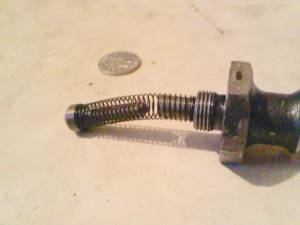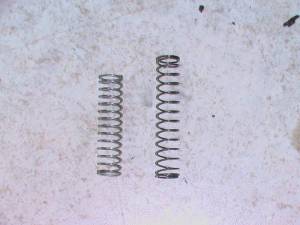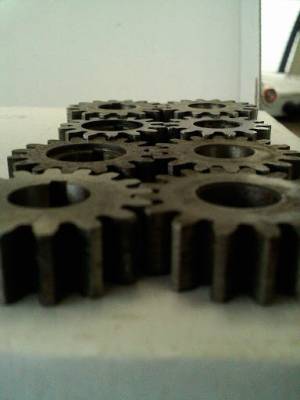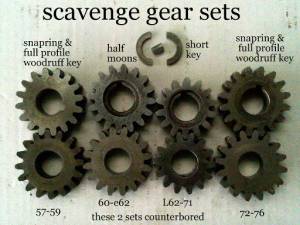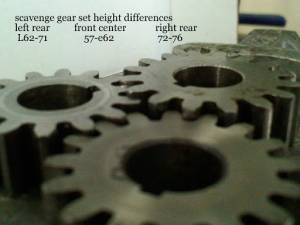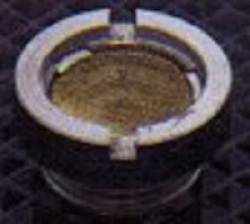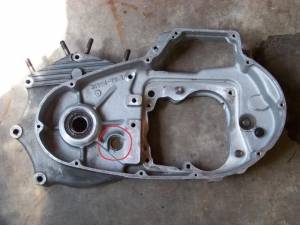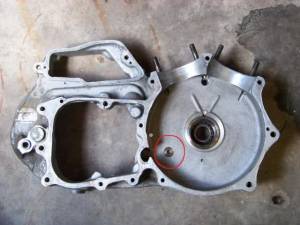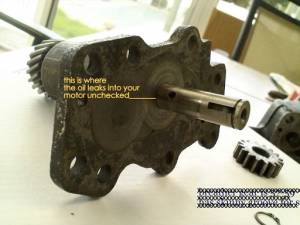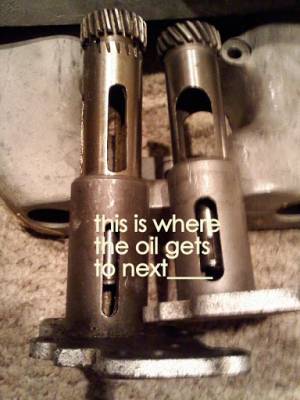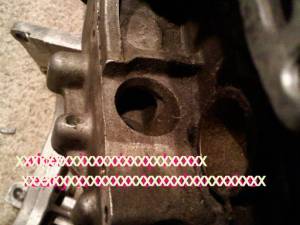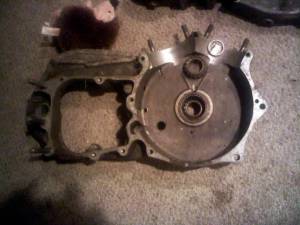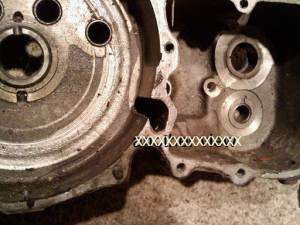Table of Contents
This is an old revision of the document!
IH: Oiling & Lubrication - Sub-03F
57-76 Oil Pump - Individual Parts and Pics
1957-E1962
- All these use 16t gear sets and style 1 plumbing 1)
- The production changes made during its run: 2)
- 57-e58 baseline pump that all others came from. no oil seal. uses a snap ring and a full profile woodruff key at scavenge gear.
- L58-59 same as above but now has body machined for a oil seal.
- 60-e62 same as L58-59 but the retaining ring at the scavenge is replaced by half moon retainers. The scavenge drive gear is counter-bored for these half moons and the woodruff key is shortened so it won't interfere with the half moons.
L1962-1971
- All these used 14t gears & scavenge sets got taller than the previous 16's were. 3)
- All use half moons and shortened key on scavenge drive.
- Bodies made till '66 are for style 1 plumbing.
- In '67, the body gets tapped for the external feed fitting for use on 67-69 XLH. This is when style2 plumbing started.
- Bodies tapped for style2 were still used on the last 3 yrs (67-69 xlch) of style1 cases.
- A plug is put in this new hole if body got used on a style1 case set.
1972-1976
- These go back to 16t gears and a snap ring with long key 4)
- Feed gears are the same as 57-e62 but the scavenge set is now wider again (wider than any of the previous sets).
- Breather gear gets enlarged slots in it. 5)
- Breather timing:
- Body and breather housing get an extra hole (2 holes now) drilled in them for additional return capacity, cases also get extra matching hole. 8)
- Solid feed gear drive pin gets replaced by the hated roll pin. 9)
- Dowels between body and breather housing are now history. 10)
- Each complete pump breaks down into these components: 11)
- Breather or sleeve gear-has the 2 slots in it
- Breather gear housing- cast iron part that breather rides in
- Feed gear set and drive pin (the skinnier of the 2 gear sets)
- Pump body
- Scavenge gear set and drive key and retaining clip.
Check Spring
There were 3 springs used from 52-76. 12)
(52-56 also used a second valve- pressure relief).
Breather Gears
(Missing are the -'56 breather gear and long full profile woodruff scavenge drive key and snap-ring). 20)
| Breather Gears 21) | Some of amf's signature quality control. These are 3 - 72 breather gears.22) | A closer view23) |
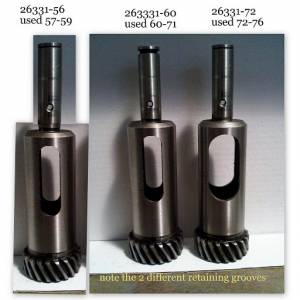 | 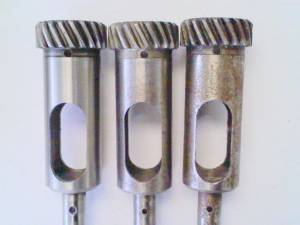 | 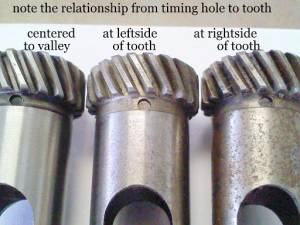 |
| The 2 different breather housings24) | Feed Gear Sets25) | More often than not the solid pin was a slipfit in cross hole.26) |
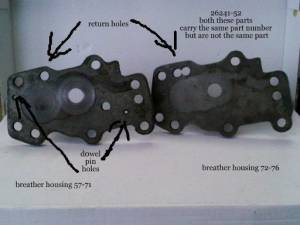 | 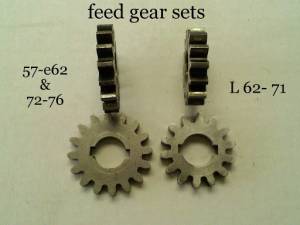 | 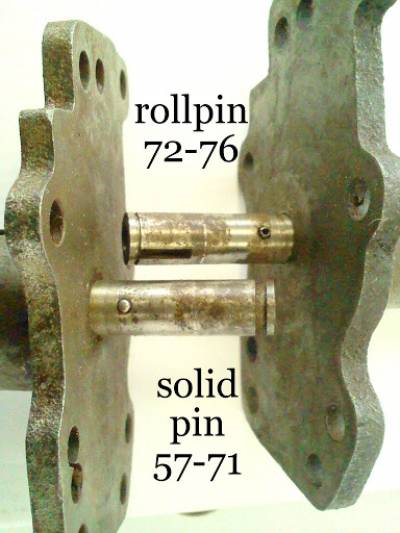 |
| On to the bodies. The 2nd text is “26217-56a L58-e62”27) | |
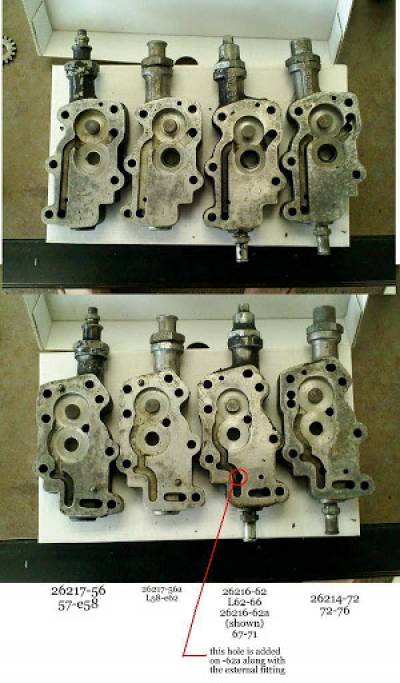 | 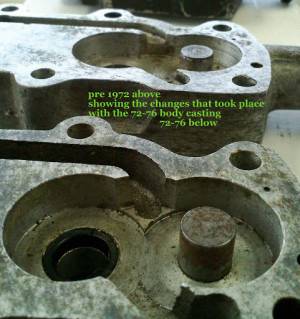 |
Transfer Valve
The foregoing by Dr Dick 31)
The transfer valve is staked into position. 32)
Look very close around the edges and you'll see two spots that have been lightly punched.
If you clean the metal away from there with a sharp instrument it will come out fairly easily.
The purpose of the transfer valve is to keep your garage floor clean.
It's an oil control device to control the oil in order to keep it in your bike.
There is so much speculation on this subject that sometimes the myth becomes the reality.
- The transfer valve is a part of a bigger system.
A system that we often break down into its components.
Then we deal with the (target component) often losing sight of the big picture.
It's our nature as mechanical guys.
Pin point the problem and then bring the hammers of Hell to bear on it.
If we can let go of that instinct for a moment this will make perfect sense.
So you want to think big picture here.
- The Transfer Valve:
- Fact: If you blow thru the valve it only allows flow from primary to engine.
- Fiction: That means its a one way check valve. Bad assumption.
It allows flow one way only when pressure is different one side of valve to other. See #3. - Fact: When taken apart carefully as not to bend the triangular reed we find no spring that 'checks' the valve when pressure differential is absent.
So it's allowed to 'leak' in state of equilibrium. - Fiction: There's something missing from this valve.
That's why its not checking and allowing leaking oil into my primary as I found when I left the primary cover off an saw the trail of oil from the valve.
If you dismiss the assumptions and stick with what we can prove this truth emerges:
The transfer valve is a one way feed when engine is running but not when engine is static.
(then it's relaxed and oil leaks from motor thru it) - Fact: Oil is leaking out of your valve when the primary cover is off.
(it's leaking when the primary cover is on too) - Fiction: There's only supposed to be a small amount of oil in the motor so there's something else wrong too. What could that be?
Aha, it's got to be the check valve in the oil pump leaking.
(This is the spot you go off course chasing ghosts. Because your motor is not running, oil is leaking into it before it even gets to the check valve).
- You are told to inspect the check valve in response to any noticeable change that increases oil exiting thru the breather tube.
Because a check that leaks will shorten the time it takes to fill the motor enough to puke. - Even a perfectly sealed check can't stop oil that's getting in thru a different path.
- If we slow down now and think, we get to this:
In order for the pump check to leak, oil has to get to the tank side of pump check.
In order to get there its got to sneak past gear clearance in pump (which it obviously does).
But this is not the only place this errant oil can go:
- So, oil is now filling the crankcase and not the cam chest.
The factory made sure that it happened like this.
They wanted this unchecked oil to stay out of the cam chest so that your bike is less likely to puke oil. - They didn't want the oil to just sit in the case sump either because it would just end up in the cam case soon after the bike was started.
- They wanted to somehow 'transfer' it to a reservoir allowing it to re-enter the engine in a controlled volume that the return pump could handle without being drowned.
- So oil flowing unchecked into the pump from the oil supply line leaks clear thru engine into primary before it can start to fill the cam chest.
On the primary side though, there is plenty of room to fill with the errant oil. - The transfer valve 'transfers' “pre pump check” oil leakage out of the motor and into the primary.
Where it re-enters the engine on startup in a controlled volume that the return pump could handle without being drowned. - In other words, it 'transfers' it back to engine when bike starts.
- This is the improvement refined from the 52-54 siphon tube that used the same valve guts.
- It does makes perfect sense don't it?
- Now, given some thought you will see why the valves aren't used on the racers.
- The '77 style oil system did away with the unchecked supply leakage. (so there is no reason to 'transfer' what isn't there).
- It's name is absolutely 100% correct: It's the transfer valve.
- The factory 'got it right' with this part.
- Keep an eye on the big picture.

